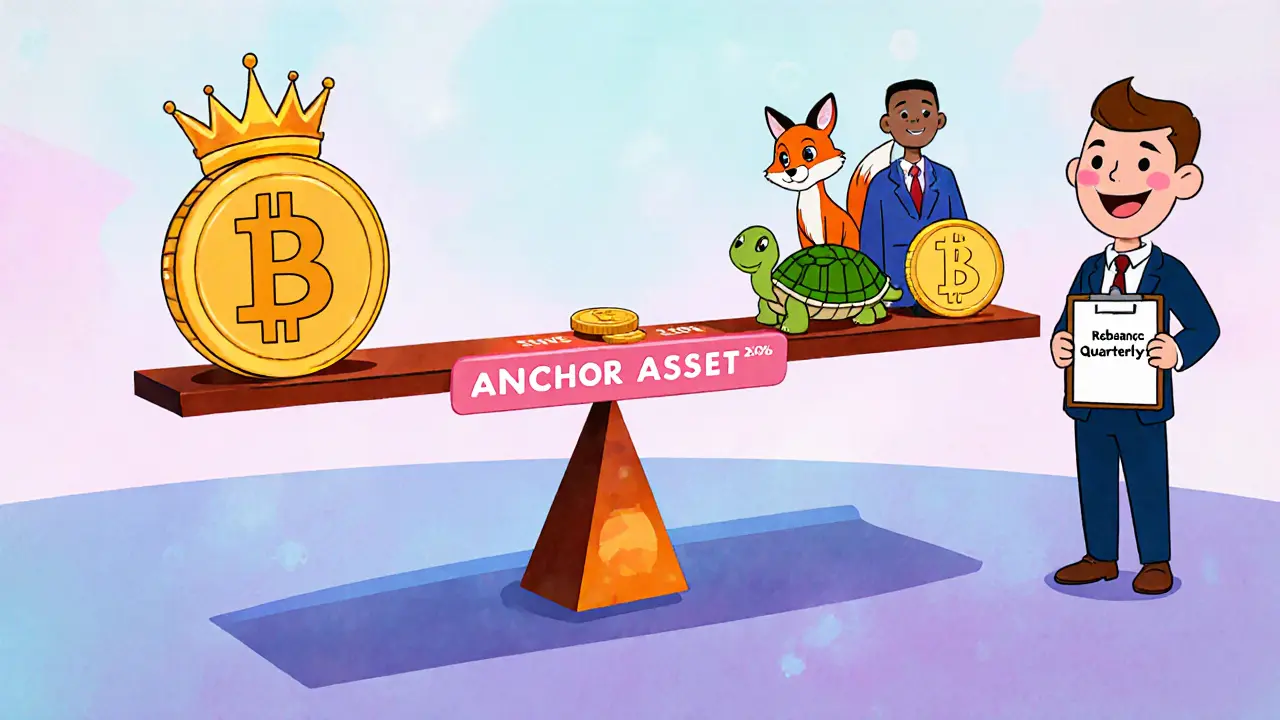Bitcoin Allocation Calculator
Optimize Your Bitcoin Allocation
Based on expert recommendations from BlackRock, VanEck, CoinShares, and Galaxy Digital.
Your Recommended Allocation
Your Investment Breakdown
Why This Allocation?
This recommendation is based on expert analysis from BlackRock, VanEck, CoinShares, and Galaxy Digital. Allocating 3-5% Bitcoin improves risk-adjusted returns while maintaining portfolio stability.
Most people who start investing in crypto think they need to go all in on Bitcoin. But that’s not how smart portfolios work. Owning Bitcoin isn’t about chasing the next 10x. It’s about Bitcoin allocation - how much of your total money should be in it, and why. The answer isn’t guesswork. It’s backed by data from BlackRock, VanEck, CoinShares, and Galaxy Digital. And the numbers tell a clear story: too little does nothing. Too much can break your portfolio.
Why Bitcoin Belongs in a Crypto Portfolio
Bitcoin isn’t just another coin. It’s the original digital asset, the most liquid, the most widely held, and the only one with proven resilience through multiple market cycles. Unlike altcoins, which can vanish overnight, Bitcoin has survived regulatory crackdowns, exchange collapses, and global economic shocks. That’s why it’s the anchor of any serious crypto portfolio. Studies show that even a small Bitcoin holding improves your portfolio’s risk-adjusted returns. Galaxy Digital found that going from 0% to 1% Bitcoin in a mix of stocks, bonds, and gold boosted the Sharpe ratio - a measure of return per unit of risk - more than any other single change. That’s not a small win. It means you got more return for the same level of risk. Or, put another way: you took less risk to get the same return. This isn’t about Bitcoin becoming the new gold. It’s about its unique behavior. Bitcoin doesn’t always move with the stock market. Sometimes, when equities drop, Bitcoin holds steady or even rises. That’s diversification. And in a world where inflation, interest rates, and geopolitics shake traditional assets, having something that doesn’t follow the same script is valuable.The Numbers: What Do the Experts Recommend?
You’ll hear all kinds of numbers floating around - 5%, 10%, even 20%. But the institutions managing trillions of dollars don’t gamble. They model. And their models point to a narrow range.- BlackRock suggests 1% to 2%. Their reasoning? Bitcoin’s risk to your portfolio is about the same as holding one of the biggest tech stocks like Apple or Microsoft in a traditional 60/40 portfolio. If you wouldn’t put 10% of your money into Apple, why put that much into Bitcoin?
- VanEck recommends 3% Bitcoin, paired with 3% Ethereum, for a total of 6% crypto exposure. Their analysis of 169 portfolios showed this mix delivered the best return for the least risk. They used monthly rebalancing to keep the numbers in check.
- CoinShares found the sweet spot between 4% and 7.5%. Their data, covering 2017 to mid-2025, showed portfolios with 4% Bitcoin delivered better risk-adjusted returns than those with 0%. At 7.5%, you’re still in the green - but you’re dancing close to the edge. Above that, volatility starts eating into your gains.
- Galaxy Digital confirmed that any allocation above 0% helps. But they found the biggest boost comes from funding Bitcoin with money pulled from equities, not bonds or cash. Why? Because Bitcoin’s volatility is lower when it replaces part of your stock exposure than when it replaces safer assets.
Notice a pattern? No one says 20%. No one says 50%. Even the most bullish firms cap their recommendations at 7.5%. That’s not because they’re scared. It’s because the math says so.
What Happens If You Go Over 7.5%?
It’s tempting. When Bitcoin surges 30% in a week, you feel like you’re missing out. You might be tempted to buy more, push your allocation to 10%, 15%, even 25%. But here’s what happens when you do:- Your portfolio’s volatility spikes. Bitcoin swings 10-20% in a day. If it’s 15% of your portfolio, that’s a 1.5-3% swing in your total net worth overnight. That’s more than most people’s monthly salary.
- You lose discipline. People who hold more than 10% in Bitcoin often panic-sell during crashes. Survey data from crypto platforms shows users with high allocations report higher stress levels and more emotional trading.
- Rebalancing becomes a nightmare. If Bitcoin jumps from 5% to 12% in six months, you have to sell a big chunk to get back to target. That means paying taxes, paying fees, and fighting the urge to hold onto your “winner.”
One Reddit user from Bristol shared how he went from 5% to 18% in Bitcoin during the 2024 bull run. When the price dropped 40% in two months, he sold half his position at a loss - not because he needed the cash, but because he couldn’t sleep at night. He later admitted he’d have been better off sticking to 5%.

Where Should the Money Come From?
You can’t just add Bitcoin without taking money from somewhere. The source matters.- From stocks? Best option. Bitcoin’s volatility is lower when it replaces part of your equity exposure. Galaxy Digital’s research showed this combo improved risk-adjusted returns the most.
- From bonds or cash? Less effective. Bonds are low-risk. Bitcoin is high-risk. Swapping safe money for risky money doesn’t improve your portfolio - it just makes it riskier.
- From other cryptos? Only if you’re replacing weak altcoins. Bitcoin should be your core. Don’t take money from Ethereum or Solana to fund more Bitcoin unless those other coins are underperforming or lack clear use cases.
Think of it like this: you wouldn’t take money from your emergency fund to buy a speculative stock. Don’t take money from your safety net to buy more Bitcoin.
How Often Should You Rebalance?
Rebalancing isn’t optional. It’s the glue that holds your allocation strategy together.- Monthly: Best for institutions. VanEck used this. But for most people, it’s overkill. Fees add up. Stress builds.
- Quarterly: The sweet spot for most investors. Check your portfolio every three months. If Bitcoin is more than 2% above your target (say, 5% → 7%), sell a little. If it’s below (5% → 3%), buy more.
- Event-based: Only rebalance when your allocation moves more than ±2% from your target. This reduces trading and keeps you focused on the long term.
Most people who fail at Bitcoin allocation don’t fail because they bought too early. They fail because they never rebalanced. They let Bitcoin become 80% of their portfolio - and then got crushed when the market turned.

What About Your Risk Tolerance?
There’s no one-size-fits-all. Your age, income, job stability, and emotional reaction to market swings matter.- Conservative investor (retired, fixed income, risk-averse): Start at 1%. If you’re nervous, stay there. Even 1% adds diversification without the sleepless nights.
- Moderate investor (working, 30-50, some savings): 3% to 5%. This is the range most people should aim for. Enough to benefit from Bitcoin’s upside, not so much that it controls your emotions.
- Aggressive investor (young, high income, understands crypto): Up to 7.5%. But only if you’ve studied the history, can hold through a 50% drop, and have other assets to fall back on.
Don’t let FOMO push you beyond your limit. If seeing your portfolio drop 10% in a week makes you want to sell everything, you’ve allocated too much.
Real-World Impact: What Does This Look Like?
Let’s say you have a £100,000 portfolio: £60,000 in stocks, £30,000 in bonds, £10,000 in cash. - At 3% Bitcoin: You move £3,000 from your stock holdings into Bitcoin. Now you have £57,000 in stocks, £30,000 in bonds, £7,000 in cash, £3,000 in Bitcoin. - At 5% Bitcoin: You move £5,000 from stocks into Bitcoin. Now £55,000 in stocks, £30,000 in bonds, £5,000 in cash, £5,000 in Bitcoin. Now, imagine the market crashes. Stocks drop 20%. Your portfolio falls to £84,000. But because Bitcoin only dropped 15%, and you rebalanced, you didn’t lose as much as someone who had 100% in stocks. Or imagine Bitcoin surges 120% in a year. Your portfolio grows to £120,000. But Bitcoin is now 6% of your portfolio instead of 5%. You sell £1,000 worth, lock in profit, and put it back into stocks. You didn’t miss the gain - you just kept your risk in check.Final Rule: Get Off Zero, But Don’t Go Crazy
The biggest mistake? Holding 0% Bitcoin. Every major institution agrees: even 1% improves your portfolio. The second biggest mistake? Holding more than 7.5%. The data doesn’t support it. The psychology doesn’t support it. The history doesn’t support it. Set your allocation based on your risk tolerance. Stick to it. Rebalance quarterly. Ignore the noise. Bitcoin isn’t a get-rich-quick scheme. It’s a long-term diversifier. And like any good diversifier, it works best when it’s small - but not absent.What’s the ideal Bitcoin allocation for a beginner?
Start with 1% to 3%. This gives you exposure to Bitcoin’s long-term growth without exposing your entire portfolio to its volatility. It’s enough to learn how it behaves in different markets without causing emotional stress. Rebalance quarterly and avoid adding more until you’re comfortable with the swings.
Should I put Bitcoin in my retirement account?
Only if your retirement platform allows it and you’re comfortable with the risk. Bitcoin isn’t a traditional retirement asset. If you’re 10 years from retirement, 1% to 2% might be acceptable. If you’re within 5 years, stick to safer assets. Never use retirement funds to chase high-risk bets.
Is it better to buy Bitcoin all at once or dollar-cost average?
Dollar-cost average. Buy a fixed amount every month - say, £50 or £100 - until you hit your target allocation. This smooths out price swings and removes timing risk. It also helps you stay disciplined. Trying to time the market with Bitcoin almost always backfires.
Can I use Bitcoin as a hedge against inflation?
Yes, but not as a direct replacement for gold or TIPS. Bitcoin’s inflation hedge effect is real over long periods - but it’s unpredictable in the short term. Use it as a small part of your inflation protection, not the whole strategy. Keep 1-2% in Bitcoin and 1-3% in gold or real estate for balance.
What if Bitcoin crashes 50%? Should I buy more?
Only if you’re still within your target allocation. If Bitcoin was at 5% and dropped to 2.5%, yes - buy back to 5%. If it was at 7.5% and dropped to 4%, don’t rush to restore it. Let your rebalancing rules guide you, not your emotions. Buying more after a crash only makes sense if you’re following a plan, not reacting to fear or greed.






Arthur Crone
1% is for cowards. If you’re not 5-10% in BTC you’re playing with Monopoly money.
Laura Hall
bro i started at 1% and now i’m at 4% after 2 years of dca and i still sleep fine. no need to go crazy. btc ain’t gonna disappear tomorrow.
Diana Dodu
USA only knows how to invest. Everyone else is just gambling. If you’re not putting 10% in Bitcoin you’re literally helping China win.
Ainsley Ross
Thank you for this well-researched piece. The data from BlackRock and VanEck is especially compelling. I appreciate how you emphasized rebalancing - too many investors forget that discipline is the real alpha.
Wayne Dave Arceo
Correction: Galaxy Digital didn’t say ‘any allocation above 0% helps.’ They said ‘statistically significant improvement begins at 0.5%.’ Also, the Sharpe ratio boost is only valid under monthly rebalancing. You omitted the critical constraint.
Rachel Everson
1% is perfect for beginners. I told my sister to start there and she’s been chill ever since. No panic selling, no FOMO, just steady growth. You don’t need to go all-in to win.
Johanna Lesmayoux lamare
1% is enough.
ty ty
So you’re telling me I shouldn’t bet my life savings on a meme coin called Bitcoin? Wow. Mind blown.
Michael Heitzer
Bitcoin isn’t an asset. It’s a paradigm shift. The 1-7.5% range? That’s the old world trying to quantify the new. The real question isn’t how much to allocate - it’s whether you’re ready to live in a world where money isn’t controlled by banks. If you’re not, then yes, stick to 1%. But if you are? You’re not investing. You’re evolving.
Rebecca Saffle
I lost 40% of my net worth because I followed this exact advice. Now I’m working two jobs and my kid’s college fund is gone. So yeah, 1%? Maybe. But don’t pretend it’s safe. It’s not. It’s gambling with your future.
Adrian Bailey
so i’ve been doing 3% since 2021 and honestly? i forgot i even had it until last month when i checked and it was up 3x. i just let it sit. no rebalancing, no stress. i think the best strategy is to set it and forget it. unless you’re a nerd who likes spreadsheets, then go nuts.
BRYAN CHAGUA
This is one of the clearest, most grounded takes on crypto allocation I’ve read in years. Thank you for grounding the conversation in data, not hype. Too many people treat Bitcoin like a lottery ticket. It’s not. It’s a hedge. A tool. A small part of a bigger picture.
tom west
Everyone cites VanEck and BlackRock like they’re gospel. But those firms manage trillions in traditional assets. They’re not trying to make you rich. They’re trying to keep their clients from losing everything. That’s why they cap it at 7.5%. They’re not bullish - they’re terrified. If you’re young and have no liabilities, 7.5% is still too low. You’re leaving 10x returns on the table.
dhirendra pratap singh
India is waking up. I put 15% in BTC last year. My uncle laughed. Now he’s crying. Who’s the fool now? 😂